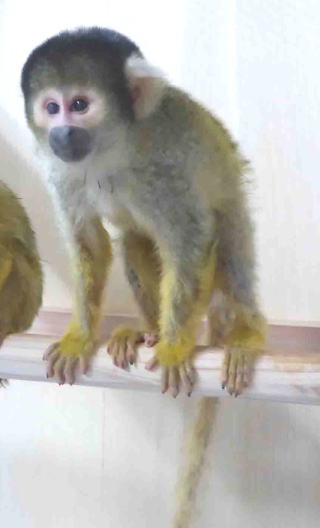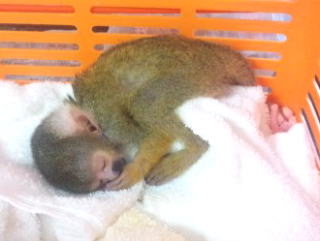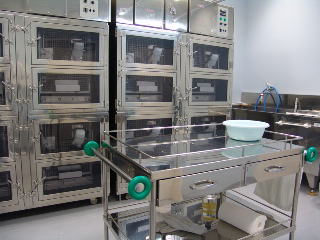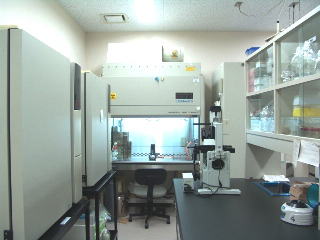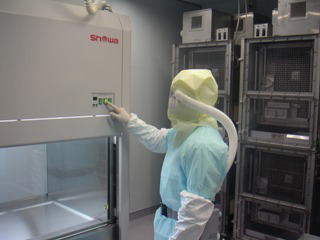Squirrel monkeys, which are classified within New World monkeys of the
Family Cebidae, live in the tropical rainforests of the central and southern America.
We have succeeded in constant breeding of squirrel monkeys native to Bolivia
(Saimiri boriviensis) since 1981, probably because the subtropical oceanic climate of Amami
Oshima was good for them. In the wild environment of the southern hemisphere,
a mating season is around June to September, and a birth season is around
December to February. However, in the northern hemisphere where our facility
located, the mating and breeding seasons are reversed. Adult males weigh
about 900-1200g and females weigh about 500-800g. Each monkey has a curious
and gentle personality, and even adult males are easily handled. Squirrel
monkeys are known as the best in vivo model of mararia, because they are
susceptible to Plasmodium falciparum.
Application Form
(Microsoft Word)
The Institute of Medical Science
The University of Tokyo
802 Tean, Setouchi-cho, Oshima-gun, Kagoshima 894-1531 JAPAN
TEL:+81-997-72-0373 FAX:+81-997-72-0277
This page is addministed by Amami Laboratory of Medical Science. All
Rights Reserved.
Copyright © Amami Laboratory of Medical Science
Owl monkeys (genus Aotus) are also small primates of the Family Cebidae native to South America. Excluding Tarsiiformes such as Tarsiers, Owl monkeys are the only nocturnal primates among Simiiformes including humans. Despite its nocturnality, their eyes have no tapetum,
and it is presumed that their ancestor evolved from diurnal to nocturnal.
Owl monkeys hide and sleep in tree hollow during the day, they become active
during the night and are able to catch flying insects even in darkness.
Their weights and body sizes are slightly larger than the squirrel monkeys.
Owl monkeys form the herd in family units. They are known to continuous
breeder, and have unique feature that males carry their baby on their back
and raise the baby except when breastfeeding. Owl monkeys are sensitive
to P.vivax and are also useful as the animal model for human malaria.
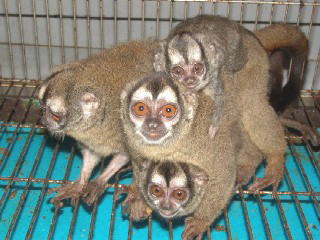

Amami Laboratory of Medical Science is international joint usage and
research center capable of infection experiment up to BSL3 pathogens in
non-human primates. In 2003, the building for infection experiment equipped
with animal experiment rooms (ABSL2, and BSL2) that can accommodate cynomolgus
monkeys and rhesus monkeys was completed. In addition, since 2005, our
facility became as a primate experimental base of the International Center
for Infectious Diseases, and in 2006, a high containment animal room for
monkeys (ABSL3) and culture room (BSL3) were also completed. We have conducted
infection experiments using various pathogens such as highly pathogenic
avian influenza virus, measles virus, equine herpesvirus, mycobacteria,
cryptosporidium, Plasmodium falciparum, and P.vivax, etc. If you have any
requests for collaborative research in primates, please contact us.
Inquiries on matters other than the above are also welcome. In the separate
building, there are the animal breeding rooms for New World monkeys, the
room for Keeping of specified animals such as poisonous snake Habu (Protobothrops
flavoviridis), the SPF mouse room, and the standard laboratory and culture
rooms (BSL2). Please feel free to contact us if there is anything we can
help you.
Squirrel monkey
under nursing by laboratory staff
Standard culture room (BSL2)
Animal rooom for monkeys
(ABSL2)
Animal experiment room
for monkeys(ABSL3)
